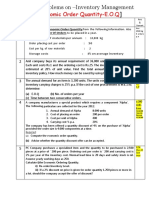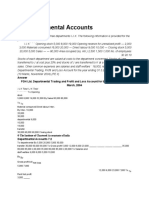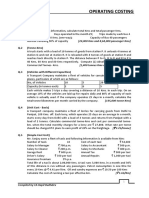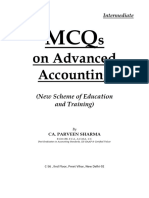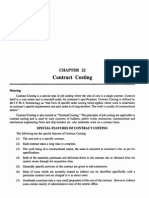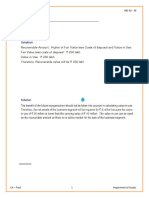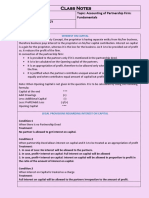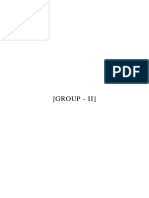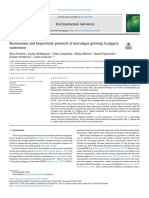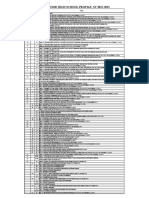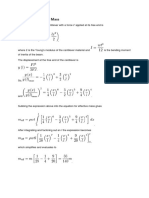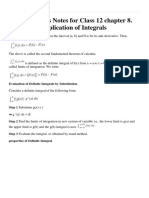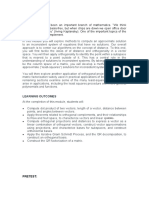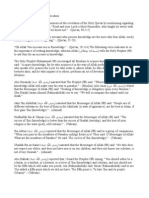Cma Scanner
Cma Scanner
Uploaded by
Vivek ReddyCopyright:
Available Formats
Cma Scanner
Cma Scanner
Uploaded by
Vivek ReddyCopyright
Available Formats
Share this document
Did you find this document useful?
Is this content inappropriate?
Copyright:
Available Formats
Cma Scanner
Cma Scanner
Uploaded by
Vivek ReddyCopyright:
Available Formats
[GROUP - II]
254
SCANNER [SEC-II]
COST AND MANAGEMENT ACCOUNTING
COST AND MANAGEMENT ACCOUNTING
BASIC ASPECTS OF COST ACCOUNTING
Objectives -Type Questions :
Q1. State whether the following statements are True (T) or False (F) : The relationship of value, function and cost can be expressed as Cost = Value/Function. [Ref : Q1. (b)(iv), June 07 / Paper-8] 1
Descriptive & Practical Questions :
Q1. State the distinguishing features of standard cost. [Ref : Q5. (a), Dec 07 / Paper-8] 5
MATERIALS
Objectives -Type Questions :
Q1. State whether the following statements are True (T) or False (F) : ABC analysis is made on the basis of unit prices of materials. [Ref : Q1. (b)(iii), June 09 / Paper-8] 1 Q2. Choose the correct answer from the brackets : The annual demand of a certain component bought from the market is 1,000 units. The cost of placing an order is Rs. 60 and the carrying cost per unit is Rs. 3 p.a. The Economic Order Quantity for the item is ___________ . (200, 400, 600) [Ref : Q1. (c)(i), June 09 / Paper-8] 1 Q3. Choose the correct answer from the brackets : In a company there were 1200 employees on the rolls at the beginning of a year and 1180 at the end, during the year 120 persons left and 96 replacements were made, the rate of labour turnover according to flux method is ___________ . (5.04, 4.03, 9.08) [Ref : Q1. (c)(iv), June 09 / Paper-8] 1
Descriptive & Practical Questions :
Q1. Write short note on JIT. [Ref : Q8. (a), Dec 08 / Paper-8] 3
SCANNER [SEC-II]
COST AND MANAGEMENT ACCOUNTING
255
LABOUR
Objective -Type Questions :
Q1. State whether the following statements are True (T) or False (F) : Time and motion study which is a function of the engineering department is useless for determination of wages. [Ref : Q1. (c)(ii), Dec. 08 / Paper-8] 1 Q2. Choose the correct answer from the brackets : In a company there were 1200 employees on the rolls at the beginning of a year and 1180 at the end. During the year 120 persons left service and 96 replacements were made. The labour turnover according to flux method is ___________ %. (5.04, 4.03, 9.08) [Ref : Q1. (e)(i), Dec. 08 / Paper-8] 1 Q3. State whether the following statements are True (T) or False (F) : Time and motion study which is a function of the engineering department is useles for determination of wages. [Ref : Q1. (b)(ii), June 09 / Paper-8] 1 Q4. Choose the correct answer from the brackets : In a company there were 1200 employees on the rolls at the beginning of a year and 1180 at the end, during the year 120 persons left and 96 replacements were made, the rate of labour turnover according to flux method is ___________ . (5.04, 4.03, 9.08) [Ref : Q1. (c)(iv), June 09 / Paper-8] 1 Q5. In the following cases, choose the correct answer : A worker has time rate of Rs. 15/hr. He makes 720 units of a component (standard time : 5 minutes/ unit in a week of 48 hours). His total wages including Rowan bonus for the week is _________ . A : Rs. 792; B : Rs. 820; C : Rs. 840; D : Rs. 864. [Ref : Q1. (e)(v), June 09 / Paper-8] 1
Descriptive & Practical Questions :
Q1. What is idle time? Explain the causes for idle time. [Ref : Q2. (a), Dec 08 / Paper-8] 5
Q2. A worker is allowed 60 hours to complete a job on a guaranteed wage of Rs. 10 per hour. He completes the job in 48 hours. For the saving in time, how much he will get under Halsey Premium Plan (@ 50% Bonus)? [Ref : Q2. (b), Dec 08 / Paper-8] 5
256
SCANNER [SEC-II]
COST AND MANAGEMENT ACCOUNTING [Ref : Q2. (a), June 09 / Paper-8] 5
Q3. Discuss the essentials of a good incentive scheme.
Q4. The standard hours for job X is 100 hours. The job has been completed by Amar in 60 hours, Akbar in 70 hours and Anthony in 95 hours. The bonus system applicable to the job is as follows : Percentage of time saved to time allowed Saving up to 10% From 11% to 20% From 21% to 40% From 41% to 100% Bonus 10% of time saved 15% of time saved 20% of time saved 25% of time saved
The rate of pay is Rs. 10 per hour. Calculate the total earnings of each worker and also the rate of earnings per hour. [Ref : Q2. (b), June 09 / Paper-8] 5
DIRECT EXPENSES
Objective -Type Questions :
Q1. If an expenses can be identified with a specific cost unit, it is treated as direct expenses. [Ref : Q1. (c)(i), Dec. 08 / Paper-8] 1 Q2. If an expenses can be identified with a specific cost unit, it is treated as direct expenses. [Ref : Q1. (b)(i), June 09 / Paper-8] 1 Q3. The monthly cost of maintenance of machinery for 12,000 machine hours run is Rs. 1,70,000 and for 18,500 hours it is Rs. 2,02,500. The cost of maintenance for 14,000 hours is Rs. ________ (1,90,000, 1,80,000, 1,85,000) [Ref : Q1. (c)(ii), June 09 / Paper-8] 1
SCANNER [SEC-II]
COST AND MANAGEMENT ACCOUNTING
257
INDIRECT EXPENSES
Objective -Type Questions :
Q1. Fill in the blanks : The term used to charge overheads to cost units is called __________ . [Ref : Q1. (b)(i), Dec. 08 / Paper-8] 1
Descriptive & Practical Questions :
Q1. A company makes components for television sets using two service departments and two production departments. The inter-departmental relationship and overhead costs are given below : Percentage of service provided to Maintenance From : Maintenance Scheduling Total overhead cost (Rs.) 20% 7,50,000 Scheduling 10% 4,00,000 Moulding 40% 50% 3,78,000 Assembly 50% 30% 2,76,00
You are required to show the amount of Scheduling Department costs and Maintenance Department costs to be allocated to the Production Department, using Simultaneous Equation Method. [Ref : Q2. (c), Dec 08 / Paper-8] 5 Q2. A company has three production departments, A, B and C and two service departments, P and Q. The following figures are available from the primary distribution summary. Department From primary distribution (Rs.) Dept. A 3,150 Dept. B 3,700 Dept. C 1,400 Dept. P 2,250 Dept. Q 1,000
The expenses of the services departments are to be apportioned on a percentage basis as follows : Department P (%) Q (%) Dept. A 40 30 Dept. B 30 30 Dept. C 20 20 Dept. P 20 Dept. Q 10
Prepare secondary summary as per the simultaneous equations method. [Ref : Q2. (c), June 09 / Paper-8] 5
258
SCANNER [SEC-II]
COST AND MANAGEMENT ACCOUNTING
JOB, BATCH, CONTRACT AND PROCESS COSTING
Objective -Type Questions :
Q1. Choose the correct answer from the brackets : The output of three different products P, Q and R in a factory are 20000 Kg, 15000 Kg. and 15000 Kg. respectively. If the costs are in proportion 4 : 6 : 7, then the cost per equivalent product unit is Rs. __________ . (10, 7, 5) [Ref : Q1. (c)(v), June 09 / Paper-8] 1 Q2. Identify the correct answer from the given alternatives of the following questions : (i) Conversion cost refers to A. Manufacturing costs incurred to produce units of output B. All costs associated with manufacturing other than direct labour costs C. The sum of direct material costs and all factory overhead costs D. The sum of raw material costs and overheads costs [Ref : Q1. (d)(ii), Dec 08 / Paper-8] 1 Q3. Choose the correct answer from the brackets : The output of three different products P, Q and R in a factory are 20000 kg, 15000 kg and 15000 kg respectively. If costs are in proportion 4 : 6 : 7, then the cost per equivalent unit is Rs. __________ . (10, 7, 5) [Ref : Q1. (e)(v), Dec 08 / Paper-8] 1
Descriptive & Practical Questions :
Q1. The following was the expenditure on a contract for Rs. 12,00,000 commenced in January 2008 : Materials Wages Plant Overheads Rs. 2,40,000 3,28,000 40,000 17,200
Cash received on account of the contract up to 31st December was Rs. 4,80,000 being 80% of the work certified. The value of materials in hand was Rs. 20,000. The plant had undergone 20% depreciation. Prepare contract account. [Ref : Q3. (a), Dec 08 / Paper-8] 5
SCANNER [SEC-II]
COST AND MANAGEMENT ACCOUNTING
259
Q2. A factory has two production processes. Normal loss in each process is 10% and scrapped units sell for Re. 0.50 each from process 1 and Rs. 3 each from process 2. Relevant information for costing purposes relating to period 5 are as follows : Direct materials added : Units Cost Direct labour Production overhead Output to Process 2/finished goods Actual production overhead Workout cost per unit of output and losses. Process 1 2,000 Rs. 8,100 Rs. 4,000 150% of direct labour cost 1,750 units Rs. 17,800 [Ref : Q3. (b), Dec 08 / Paper-8] 10 [Ref : Q3. (a), June 09 / Paper-8] 5 Process 2 1,250 Rs. 1,900 Rs. 10,000 120% of direct labour cost 2,800 units
Q3. State the fundamental principles of Process Costing.
Q4. Prabhu Builders Ltd. commenced work on 1st April, 2007 on a contract of which the agreed price was Rs. 5 lakhs. The following expenditure was incurred during the year up to 31st March, 2008. Particulars Wages Plant Materials Head office expenses Amount Rs. 1,40,000 35,000 1,05,000 12,500
Materials costing Rs. 10,000 proved unsuitable and were sold for Rs. 11,500 and a part of plant was scrapped and sold for Rs. 1,700. Of the contract price Rs. 2,40,000 representing 80% of work certified had been received by 31st March, 2008 and on that date the value of the plant on the job was Rs. 8,000 and the value of materials was Rs. 3,000. The cost of work done but not certified was Rs. 25,000. It was decided to (a) Estimate what further expenditure would be incurred in completing the contract, (b) Compute from the estimate and the expenditure already incurred, the total profit that would be made on the contract and (c) Ascertain the amount of profit to be taken to the credit of Profit and Loss Account for the year ending on 31st March, 2008. While taking profit to the credit of Profit and Loss A/c. that portion of the total profit should be taken which the
260
SCANNER [SEC-II]
COST AND MANAGEMENT ACCOUNTING
value of work certified bears to the contract price. Details of the estimates to complete the contact are given below : (a) That the contract would be completed by 30th September, 2008. (b) The wages to complete would amount Rs. 84,750. (c) That materials in addition to those in stock on 31st March, 2008 would cost Rs. 50,000. (d) The further Rs. 15,000 would have to be spent on plant and the residual value of the plant on 30th September, 2008 would be Rs. 6,000. (e) The head office expenses to the contract would be at the same annual rate as in 2007-08. (f) That claims, temporary maintenance and contigencies would require Rs. 9,000. Prepare contract account for the year ended 31st March, 2008 and show your calculations of the sum to be credited to Profit and Loss A/c. for the year. [Ref : Q3. (b), June 09 / Paper-8] 10
JOINT PRODUCT & BY PRODUCT
Descriptive & Practical Questions :
Q1. Concept of split-off point and joint cost. [Ref : Q8. (e)(i), June 09 / Paper-8] 3
SCANNER [SEC-II]
COST AND MANAGEMENT ACCOUNTING
261
RECONCILIATION BETWEEN COST AND FINANCIAL PROFIT AND LOSS ACCOUNT
Descriptive & Practical Questions :
Q1. As of 31st March, 2008, the following balances existed in a firms cost ledger, which is maintaind separately on a double entry basis : Debit Rs. Stores Ledger Control A/c Work-in-progress Control A/c Finished Goods Control A/c Manufacturing Overhead Control A/c Cost Ledger Control A/c Total During the next quarter, the following items arose : Finished Product (at cost) Manufacturing overhead incurred Raw material purchased Factory wages Indirect labour Cost of sales Materials issued to production Sales returned (at cost) Materials returned to suppliers Manufacturing overhead charged to production 2,25,000 85,000 1,25,000 40,000 20,000 1,75,000 1,35,000 9,000 13,000 85,000 3,00,000 1,50,000 2,50,000 7,00,000 Credit Rs. 15,000 6,85,000 7,00,000
You are required to prepare the Cost Ledger Control A/c., Stores Ledger Control A/c., Work-in progress Control A/c., Finished Stock Ledger Control A/c., Manufacturing Overhead Control A/c., Wages Control A/c., Cost of Sales A/c and the Trial Balance at the end of the quarter. [Ref : Q7. (a), June 09 / Paper-8] 10 Q2. Explain the need for reconciliation of cost and financial accounts. Also state the reasons for difference in profit between the two accounts. [Ref : Q7. (b), June 09 / Paper-8] 5 Q3. Write short note on Profit Centre. [Ref : Q8. (c), June 09 / Paper-8] 3
262
SCANNER [SEC-II]
COST AND MANAGEMENT ACCOUNTING
DECISION MAKING TOOLS
Objective -Type Questions :
Q1. Fill in the blanks : (i) Sales minus Break-even sales is called __________ . (ii) In absorption costing ___________ cost is added to inventory. (iii) In Television industry the most appropriate method of costing is ________ costing. [Ref : Q1. (b), Dec. 08 / Paper-8] 13
Q2. State whether the following statements are True (T) or False (F) : (i) Fixed costs vary with volume rather than time. (ii) In break-even analysis it is assumed that variable fosts fluctuate inversely with time. [Ref : Q1. (b), Dec 08 / Paper-8] 12 Q3. Identify the correct answer from the given alternatives of the following questions : (i) Which of the following concept is known as cost behaviour-oriented approach to product costing? A. Standard costing B. Marginal costing C. Process costing D. Absorption costing (ii) Which of the following is true at break-even point? A. Total Sales revenue = Variable cost B. Profi = Fixed cost C. Sales revenue = Total cost Variable cost D. Contribution = Fixed cost (iii) Which of the following is the correct valuation base for finished goods stock for balance sheet purposes? A. Variable cost per unit B. Marginal cost per unit C. Production cost per unit D. Total cost per unit (iv) If the raw material prices are affected by inflation, which of the following methods of valuing stocks will give the lowest gross profit? A. LIFO B. Replacement cost C. FIFO D. Simple average [Ref : Q1. (d), Dec 08 / Paper-8] 14
SCANNER [SEC-II]
COST AND MANAGEMENT ACCOUNTING
263
Q4. Choose the correct answer from the brackets : The variable cost of a product increases by 10% and the management raise the unit selling price by equal amount. The fixed costs remain unchanged. Then BEP of the firm ___________ . [increase, decrease, unchanged] [Ref : Q1. (e), Dec 08 / Paper-8] 1 Q5. Choose the correct answer from the brackets : A companys fixed cost amounts Rs. 120 lakhs p.a. and its overall P/V ratio is 0.4. The annual sales of the company should be Rs. ____________ lakhs to have a Margin of Safety of 25%. (400, 500, 600) [Ref : Q1. (c)(iii), June 09 / Paper-8] 1 Q6. Fill in the blanks suitably : (i) Margin of safety is _____________ or _____________ . (ii) Profit volume graph shows the relationship between ____________ and ___________. [Ref : Q1. (d), June 09 / Paper-8] 12 Q7. In the following cases, choose the correct answer : A Company maintains a margin of safety of 25% on its current sales and earns a profit of Rs. 30 lakhs per annum. If the company has a profit volume (P/V) ratio of 40%, its current sales amount to A : Rs. 200 lakhs; B : Rs. 300 lakhs; C : Rs. 325 lakhs; D : None of the above. [Ref : Q1. (e)(ii), June 09 / Paper-8] 1
Descriptive & Practical Questions :
Q1. Distinguish between Marginal Costing and Absorption Costing. [Ref : Q7. (a), Dec 08 / Paper-8] 5 Q2. A company produces 30,000 units of product A and 20,000 units of product B per annum. The sales value and costs of the two products are as follows : Sales Value : Rs. 7,60,000 Direct Material : Rs. 1,40,000 Direct Labour : Rs. 1,90,000 Factory Overheads : Administrative and Selling Overheads : Rs. 1,90,000 Rs. 1,20,000
50% of the factory overheads are variable and 50% of the administrative and selling overheads are fixed. The selling price of A is Rs. 12 per unit and Rs. 20 per unit for B. The direct material and labour ratio for product A is 2 : 3 and for B is 4 : 5. For both the products, the selling price is 400% of direct labour. The factory overheads are charged in the ratio of direct labour and administrative and selling overheads are recovered at a flat rate of Rs. 2 per unit for A and Rs. 3 per unit for B.
264
SCANNER [SEC-II]
COST AND MANAGEMENT ACCOUNTING
Due to fall in demand of the above products, the company has a plan to diversify and make product C using 40% capacity. It has been estimated that for C direct material and direct labour will be Rs. 2.50 and Rs. 3 per unit respectively. Other variable costs will be the same as applicable to the product A. The selling price of product C is Rs. 14 per unit and production will be 30,000 units. Assuming 60% capacity is used for manufacture of A and B, calculate (i) Present cost and profit; (ii) Cost and profit after diversification; (iii) Give your recommendations as to whether to diversify or not. [Ref : Q7. (b), Dec 08 / Paper-8] 10 Q3. Write short note on Benchmarking. [Ref : Q8. (c), Dec 08 / Paper-8] 3
Q4. New India Engineering Co. Ltd., produces three components A, B and C. The following particulars are provided : PRODUCT A Rs. 60 20 15 13 2000 B Rs. 55 18 14 13 2000 C Rs. 50 15 12 17 2000
Per Unit Sale Price Direct Material Direct Labour Variable overhead expenditure Fixed Cost is Rs. 1,00,000 per year. Estimated Sales (in No. of Units)
Due to break-down of one of the machines, the capacity is limited to 12,000 machine hours only and this is not sufficient to meet the total sales demand. You are required to work out (a) what will be most profitable product mix that should be produced, and (b) the total contribution from the revised product mix. [Ref : Q4. (a), June 09 / Paper-8] 5+5 Q5. What are the factors those are taken into account by the Management while considering a Make or Buy decision? [Ref : Q4. (b), June 09 / Paper-8] 5 Q6. Write short note on Cost Volume Profit Analysis. [Ref : Q8. (a), June 09 / Paper-8] 3
Q7. Write short note on Essentials of Inter firm comparison. [Ref : Q8. (d), June 09 / Paper-8] 3
SCANNER [SEC-II]
COST AND MANAGEMENT ACCOUNTING
265
OPERATING COSTING
Descriptive & Practical Questions :
Q1. A hotel has a capacity of 100 single rooms and 20 double rooms. The average occupancy of both single and double rooms is expected to be 80% throughout the year of 365 days. The rent for the double rooms has been fixed at 125% of the rent of the single room. The costs are as under : Variable costs : Single room Rs. 220 each per day; Double room Rs. 350 each per day. Fixed costs : Rs. 49,64,000
Calculate the rent chargeable for single and double rooms per day in such a way that the hotel earns a margin of safety of 20% on hire of room. [Ref : Q4. (b), Dec 08 / Paper-8] 10 Q2. Define Operating Costing and mention at least five activities where it is applicable. [Ref : Q6. (b), June 09 / Paper-8]
RELEVANT COSTING
Objective -Type Questions :
Q1. State whether the following statements are True (T) or False (F) : Future costs are not relevant while making managerial decisions. [Ref : Q1. (c)(iv), Dec 08 / Paper-8] 1
266
SCANNER [SEC-II]
COST AND MANAGEMENT ACCOUNTING
BUDGETING
Objective -Type Questions :
Q1. Fill in the blanks suitably : A flexible budget recognizes the behaviour of _____________ and _____________ . [Ref : Q1. (d)(iii), June 09 / Paper-8] 1
Descriptive & Practical Questions :
Q1. The following are the estimated sales of a company for eight months ending 30. 11.2007 Month April 2007 May 2007 June 2007 July 2007 August 2007 September 2007 October 2007 November 2007 Estimated Sales (Units) 12,000 13,000 9,000 8,000 10,000 12,000 14,000 12,000
As a matter of policy, the company maintains the closing balance of finished goods and raw materials as follows : Stock item Finished goods Raw materials Closing balance of a month 50% of the estimated sales for the next month Estimated consumption for the next month
Every unit of production requires 2 kg of raw material costing Rs. 5 per kg. Prepare Prodcution Budget (in units) and Raw Material Purchase Budget (in units and cost) of the company for the half year ending 30 September 2007. [Ref : Q6. (a), Dec 08 / Paper-8] 10
SCANNER [SEC-II]
COST AND MANAGEMENT ACCOUNTING
267 [Ref : Q8. (e), Dec 08 / Paper-8] 3
Q2. Write short note on Flexible Budgeting.
Q3. The following information relates to the production activities of Good Wish Ltd. for 3 months ending on 31st December, 2006 : Particulars Fixed Expenses : Management Salaries Rent and Taxes Depreciation of Machinery Sundry Office Expenses Total Fixed Expenses Semi-Variable Expenses at 50% capacity Plant Maintenance Labour Salesmens salaries Sundry Expenses Total Semi-Variable Expenses Variable Expenses at 50% capacity Materials Labour Salesmens commission Total Variable Expenses 6,00,000 6,40,000 95,000 13,35,000 62,500 2,47,000 72,500 65,000 4,47,000 2,10,000 1,40,000 1,75,000 2,22,000 7,47,000 Amount in Rupees
It is further noted that semi-variable expenses remain constant between 40% and 70% capacity, increase by 10% of the above figures between 70% and 85% capacity and increase by 15% of the above fig. between 85% and 100% capacity. Fixed expenses remain constant whatever the level of activity. Sales at 60% capacity are Rs. 25,50,000, at 80% capacity Rs. 34,00,000 and at 100% capacity Rs. 42,50,000. All items produced are sold. Prepare a flexible budget at 60%, 80% and 100% productive capacity. [Ref : Q6. (a), June 09 / Paper-8] 10
268
SCANNER [SEC-II]
COST AND MANAGEMENT ACCOUNTING
STANDARD COSTING
Objective -Type Questions :
Q1. Fill in the blanks : Material usage variance is the sum of _____________ . [Ref : Q1. (b)(iii), Dec 08 / Paper-8] 1 Q2. Choose the correct answer from the brackets : The factory where standard costing is followed, 4600 kg of materials at Rs. 10.50/kg were actually consumed resulting in a price variance of Rs. 4800 (A) and usage variance of Rs. 4000 (F). The standard cost of actual production is Rs. ___________ . [100000, 96000, 120000] [Ref : Q1. (e)(iii), Dec 08 / Paper-8] 1 Q3. If the capacity usage ratio of a prodcution department is 90% and acitivity ratio is 99%, then the efficiency ratio of the department is __________ %. [120, 110, 90] [Ref : Q1. (e), Dec 08 / Paper-8] 1 Q4. Standard hour is the standard time required per unit of production. [Ref : Q1. (b)(v), June 09 / Paper-8] 1 Q5. Fill in the blanks suitably : (i) Material usage variance is the sum of ____________ and ________________ . (ii) Efficiency is basically a ratio of ____________ and _____________ . [Ref : Q1. (d)(ii)(v), June 09 / Paper-8] 1+1 Q6. In the following cases, choose the correct answer : In a factory of PEE Ltd. where standard costing is followed, the budgeted fixed overhead for a budgeted production of 4800 units is Rs. 24,000. For a certain period actual expenditure incurred was Rs. 22,000 resulting in a fixed overhead volume variance of Rs. 3,000 (Adv.). Then actual production for the period was A : 5400 units; B : 4200 units; C : 3000 units; D : None of the above. [Ref : Q1. (e)(iii), June 09 / Paper-8] 1
Descriptive & Practical Questions :
Q1. State the distinguishing features of standard cost. [Ref : Q5. (a), Dec 08 / Paper-8] 5
SCANNER [SEC-II]
COST AND MANAGEMENT ACCOUNTING
269
Q2. The following information was obtained from the records of a manufacturing unit using standard costing system : Particulars Production Working days Fixed overheads Variable overheads Calculate : (a) Variable overhead variance; (b) Fixed overhead expenditure variance; (c) Fixed overhead volume variance; (d) Fixed overhead efficiency variance; (e) Fixed overhead calandar variance. Standards 4000 units 20 Rs. 40,000 Rs. 12,000 Actual 3800 units 21 Rs. 39,000 Rs. 12,000
[Ref : Q5. (b), Dec 08 / Paper-8] 10
Q3. The standard process cost card for a processed item is as under : Rs. Per kg of Finished Product 20 60 90 170
Direct Material 2 kgs @ Rs. 10 per kg Direct Labour 3 hours @ Rs. 20 per hour Fixed Overhead Total
Budgeted output for the period is 1000 kgs. Actual production and cost data for a month are as under : Actual production (on equivalent production basis) Material = Labour = Overheads = 1400 kgs 1140 kgs 1140 kgs = cost = cost Rs. Rs. Rs. 32,000 68,000 88,000
Direct Material 2900 kgs Direct Labour 3300 kgs Fixed Overhead 3300 kgs You are required to work out the following variances :
[Ref : Q5. (a), June 09 / Paper-8] 10 5
Q4. Distinguish between Standard Costing and Budgetary Control. [Ref : Q5. (b), June 09 / Paper-8]
You might also like
- AFC Coaches Log BookDocument10 pagesAFC Coaches Log BookRais Fakhri Bin Azha100% (3)
- Paper - 1: Financial Reporting Questions Consolidated Balance Sheet (Chain Holding)Document52 pagesPaper - 1: Financial Reporting Questions Consolidated Balance Sheet (Chain Holding)Anonymous duzV27Mx3No ratings yet
- The Complete Guide To LIMS & Laboratory Informatics - 2016 EditionDocument225 pagesThe Complete Guide To LIMS & Laboratory Informatics - 2016 Editionmaximix75% (4)
- MCQ Testing of HypothesisDocument10 pagesMCQ Testing of HypothesisJosé Juan Góngora Cortés86% (7)
- Gls University Faculty of Commerce Sub: Advanced Corporate Account - 2 Objective Questions (17-18) Unit:-Accounts of Banking CompaniesDocument11 pagesGls University Faculty of Commerce Sub: Advanced Corporate Account - 2 Objective Questions (17-18) Unit:-Accounts of Banking Companiessumathi psgcas0% (1)
- Selenium 75 PDFDocument6 pagesSelenium 75 PDFTanpreet SinghNo ratings yet
- Assignment 1556954208 SmsDocument59 pagesAssignment 1556954208 SmsentertainmentqurryNo ratings yet
- Chapter 3Document11 pagesChapter 3Arun Kumar SatapathyNo ratings yet
- IT Income From Other Sources Pt-2Document7 pagesIT Income From Other Sources Pt-2syedfareed596100% (1)
- MTP1 May2022 - Paper 5 Advanced AccountingDocument24 pagesMTP1 May2022 - Paper 5 Advanced AccountingYash YashwantNo ratings yet
- Assignment Cost Sheet SumsDocument3 pagesAssignment Cost Sheet SumsMamta PrajapatiNo ratings yet
- Profit Prior To IncorporationDocument49 pagesProfit Prior To IncorporationKhushal SoniNo ratings yet
- Cost DJB - MTP Oct21Document10 pagesCost DJB - MTP Oct21Bharath Krishna MVNo ratings yet
- Accounting and Finance Numericals Problems and AnsDocument11 pagesAccounting and Finance Numericals Problems and AnsPramodh Kanulla0% (1)
- 2.problems On EOQ - 14.12.2018Document3 pages2.problems On EOQ - 14.12.2018Rajesh GuptaNo ratings yet
- Unit - 2: Underwriting of Shares and Debentures: Learning ObjectivesDocument15 pagesUnit - 2: Underwriting of Shares and Debentures: Learning ObjectivesTushar JoshiNo ratings yet
- Group 2 May 07Document73 pagesGroup 2 May 07princeoftolgate100% (1)
- Ca Ipcc Costing and Financial Management Suggested Answers May 2015Document20 pagesCa Ipcc Costing and Financial Management Suggested Answers May 2015Prasanna KumarNo ratings yet
- AS 25 Interim Financial ReportingDocument22 pagesAS 25 Interim Financial ReportingHemanth SNo ratings yet
- Group II - June 2010 Cost and Management Accounting: The Figures in The Margin On The Right Side Indicate Full MarksDocument23 pagesGroup II - June 2010 Cost and Management Accounting: The Figures in The Margin On The Right Side Indicate Full MarksMahesh BabuNo ratings yet
- BA7106-Accounting For Management Question Bank - Edited PDFDocument10 pagesBA7106-Accounting For Management Question Bank - Edited PDFDhivyabharathiNo ratings yet
- Department AccountsDocument14 pagesDepartment Accountsjashveer rekhiNo ratings yet
- 13 17227rtp Ipcc Nov09 Paper3aDocument24 pages13 17227rtp Ipcc Nov09 Paper3aemmanuel JohnyNo ratings yet
- Paper - 1: Principles & Practice of Accounting Questions True and FalseDocument29 pagesPaper - 1: Principles & Practice of Accounting Questions True and FalsePiyush GoyalNo ratings yet
- Tally Model Question PaperDocument2 pagesTally Model Question PaperMahaveer Choudhary100% (1)
- Solved Problems: OlutionDocument5 pagesSolved Problems: OlutionSavoir PenNo ratings yet
- (Finished Goods/stock in Trade) (Work - In-Progress) (Raw Material, Stores and Spares, Etc.)Document20 pages(Finished Goods/stock in Trade) (Work - In-Progress) (Raw Material, Stores and Spares, Etc.)razorNo ratings yet
- 1.2 Alteration of Share CapitalDocument5 pages1.2 Alteration of Share CapitalSakshi chauhanNo ratings yet
- Journal Entries For The Issue of Bonus SharesDocument2 pagesJournal Entries For The Issue of Bonus Sharesananthu p santhosh0% (1)
- Operating CostingDocument6 pagesOperating CostingAvilash Vishal MishraNo ratings yet
- Tax AnswersDocument168 pagesTax AnswersukqrnnnjhfwsxqoykuNo ratings yet
- Answer To MTP - Final - Syllabus 2008 - Jun2014 - Set 1Document18 pagesAnswer To MTP - Final - Syllabus 2008 - Jun2014 - Set 1Tushar BhatiNo ratings yet
- LEVERAGE Online Problem SheetDocument6 pagesLEVERAGE Online Problem SheetSoumendra RoyNo ratings yet
- Special QuestionsDocument42 pagesSpecial QuestionsSaloni BansalNo ratings yet
- Accounts Ques Nov06Document48 pagesAccounts Ques Nov06api-3825774No ratings yet
- Final AccountsDocument15 pagesFinal AccountsVaishnavi VyapariNo ratings yet
- 3 Pre - PostDocument7 pages3 Pre - PostParul Bhardwaj VaidyaNo ratings yet
- Advance Account MCQ BookDocument78 pagesAdvance Account MCQ Bookcloudstorage567No ratings yet
- OrganizedDocument71 pagesOrganizedRam krushna PandaNo ratings yet
- 3 - Place of Supply Long Answer Type QuestionsDocument7 pages3 - Place of Supply Long Answer Type QuestionsMighty SinghNo ratings yet
- MCQ Financial Accounting II PDFDocument23 pagesMCQ Financial Accounting II PDFSurya ShekharNo ratings yet
- BCom VI Analysis of Financial StatementsDocument3 pagesBCom VI Analysis of Financial StatementsVaibhav BanjanNo ratings yet
- Branch Accounting - ICMAIDocument51 pagesBranch Accounting - ICMAIdbNo ratings yet
- Chapter 22 Contract Costing - NoRestrictionDocument18 pagesChapter 22 Contract Costing - NoRestrictionMohammad SaadmanNo ratings yet
- Budget Imp Qs PDFDocument13 pagesBudget Imp Qs PDFkritikaNo ratings yet
- As 7 Construction ContractDocument5 pagesAs 7 Construction ContractPankaj Meena100% (1)
- Budgetary ControlDocument28 pagesBudgetary ControlDidie Diyanah0% (1)
- CMA Inter Management Accounting Importent QuestionsDocument37 pagesCMA Inter Management Accounting Importent QuestionsHarriniNo ratings yet
- Chap 5 PDFDocument22 pagesChap 5 PDFHiren ChauhanNo ratings yet
- Mock Test QuestionsDocument36 pagesMock Test QuestionsKish VNo ratings yet
- (Hons.) Financial Markets, Institutions and Financial Services SEM-V (5746) PDFDocument4 pages(Hons.) Financial Markets, Institutions and Financial Services SEM-V (5746) PDFSP SinghNo ratings yet
- 4 Internal ReconstructionDocument38 pages4 Internal ReconstructionsmartshivenduNo ratings yet
- Ind As 36 Revised - Corrected (Final Edited)Document53 pagesInd As 36 Revised - Corrected (Final Edited)Sharithra KarthikeyanNo ratings yet
- CHAP - 5 SalaryDocument44 pagesCHAP - 5 Salarypriya chauhanNo ratings yet
- Class Notes: Class: XII Topic: Accounting of Partnership Firm: Fundamentals Subject: ACCOUNTANCYDocument4 pagesClass Notes: Class: XII Topic: Accounting of Partnership Firm: Fundamentals Subject: ACCOUNTANCYDilip ChenaniNo ratings yet
- CS Exec - Prog - Paper-2 Company AC Cost & Management AccountingDocument25 pagesCS Exec - Prog - Paper-2 Company AC Cost & Management AccountingGautam SinghNo ratings yet
- MA PYQ'sDocument36 pagesMA PYQ'sbokachodasoumen6No ratings yet
- AccountingDocument40 pagesAccountingAshwani K SharmaNo ratings yet
- Operation Management and Information SystemDocument32 pagesOperation Management and Information SystemaanandlNo ratings yet
- Revalidation Test Paper Intermediate Group II: Revised Syllabus 2008Document6 pagesRevalidation Test Paper Intermediate Group II: Revised Syllabus 2008sureka1234No ratings yet
- ACCT 321-Magerial AccountingDocument6 pagesACCT 321-Magerial AccountingNodeh Deh Sparta100% (1)
- (WWW - Entrance-Exam - Net) - Mumbai University B.com Sample Paper 1Document4 pages(WWW - Entrance-Exam - Net) - Mumbai University B.com Sample Paper 1mysouldeepNo ratings yet
- Method of Costing (I)Document8 pagesMethod of Costing (I)anon_672065362No ratings yet
- Cma612s - Cost Management Accounting - 1st Opp - Nov 2019Document7 pagesCma612s - Cost Management Accounting - 1st Opp - Nov 2019Nolan TitusNo ratings yet
- Central Excise Act Notes For Self PreparationDocument29 pagesCentral Excise Act Notes For Self PreparationVivek ReddyNo ratings yet
- Reaching Strategic EdgeDocument14 pagesReaching Strategic EdgeVivek ReddyNo ratings yet
- Data Storage, Retrieval and DBMSDocument31 pagesData Storage, Retrieval and DBMSVivek Reddy100% (1)
- TDS On Printing & StationeryDocument11 pagesTDS On Printing & StationeryVivek Reddy100% (1)
- Sec 17 of Indian Registration ActDocument5 pagesSec 17 of Indian Registration ActVivek ReddyNo ratings yet
- Section 37 CaselawsDocument17 pagesSection 37 CaselawsVivek ReddyNo ratings yet
- Profit and Loss Account PDFDocument10 pagesProfit and Loss Account PDFVivek ReddyNo ratings yet
- CAclubindia News - Managerial Remuneration (In A Simple Way) PDFDocument3 pagesCAclubindia News - Managerial Remuneration (In A Simple Way) PDFVivek ReddyNo ratings yet
- Semester-Long Internship Report: Tanmay Srinath (BMSCE, Bangalore)Document31 pagesSemester-Long Internship Report: Tanmay Srinath (BMSCE, Bangalore)hiiNo ratings yet
- System Design and Modeling With SimulinkDocument0 pagesSystem Design and Modeling With SimulinkSharmila ChowdhuriNo ratings yet
- Unit 4 - Week 3 - Conditional Executions and Loops, Data Management With SequencesDocument8 pagesUnit 4 - Week 3 - Conditional Executions and Loops, Data Management With SequencesxlntyogeshNo ratings yet
- ZC 226 PDFDocument1 pageZC 226 PDFZane WaveNo ratings yet
- Government Postgraduate Jahanzeb College Pre MedicalDocument1 pageGovernment Postgraduate Jahanzeb College Pre MedicalTahir UllahNo ratings yet
- Error SpottingDocument3 pagesError SpottingselvambhrNo ratings yet
- 001-Manual ApolloDocument2 pages001-Manual ApolloAhmed MohmaedNo ratings yet
- Consumer Protection Rights in BangladeshDocument34 pagesConsumer Protection Rights in Bangladeshmd.jewel ranaNo ratings yet
- 1 s2.0 S2666765721000338 MainDocument9 pages1 s2.0 S2666765721000338 MaincelestinogarciaNo ratings yet
- Alkyl Halides and Amines - PreMedDocument27 pagesAlkyl Halides and Amines - PreMedShahzadNo ratings yet
- GJHSP Sy 2022-2023 11292022Document64 pagesGJHSP Sy 2022-2023 11292022MERY JEAN CATACUTANNo ratings yet
- 0901d196803a73d6 MP5446Document8 pages0901d196803a73d6 MP5446arturo chavezNo ratings yet
- Graduate Study at LSEDocument34 pagesGraduate Study at LSEgemmaannecorriganNo ratings yet
- Causes and Patterns of Female Criminalit 1Document17 pagesCauses and Patterns of Female Criminalit 1api-634297433No ratings yet
- Capstone ProjectDocument5 pagesCapstone ProjectethelfajardoNo ratings yet
- Teknologi Proses ProduksiDocument36 pagesTeknologi Proses ProduksiMuhammad Algifary HaskaNo ratings yet
- Cantilever Effective Mass of CANTILEVERDocument1 pageCantilever Effective Mass of CANTILEVERshangz1511No ratings yet
- 12 Math Notes CHP 9Document13 pages12 Math Notes CHP 9Shah KavishNo ratings yet
- Xamidea Human ReproductionDocument42 pagesXamidea Human Reproductionkeren spamzNo ratings yet
- Orthogonal ComplementDocument6 pagesOrthogonal ComplementmalynNo ratings yet
- Types of Defects After and While ConsructionDocument10 pagesTypes of Defects After and While Consructionanon_831233388100% (1)
- Chapter 10 Justice and FairnessDocument22 pagesChapter 10 Justice and FairnessFallaria Paulo A.No ratings yet
- Image StenographyDocument77 pagesImage StenographyRohan lokhandeNo ratings yet
- Importance of Islamic EducationDocument2 pagesImportance of Islamic EducationSaifullah Bismillah100% (1)
- Desmodur 44V20L (описание англ.)Document2 pagesDesmodur 44V20L (описание англ.)Сергей ГороднийNo ratings yet
- FDocument87 pagesFMuhammad Luki SNo ratings yet














